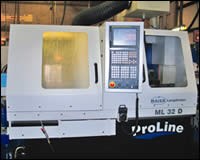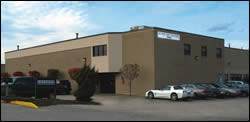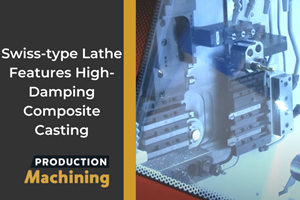Swiss Precision And Flexibility Help Shop Compete
This company is so pleased with its new Swiss-type turning center's performance that the company president calls it "the best possible way to keep this work in the United States." As his research indicated, the machine reduces labor costs by completing four or more machining operations in a single setup
It takes foresight these days for a machine shop to hold onto customers who are tempted by lower labor costs in Asia. One New England machine shop’s purchase of a new Swiss-type turning center demonstrates such foresight.
“In today’s competitive global marketplace, it’s not enough to offer great precision,” explains David Lavigne, president of Lavigne Manufacturing, Inc. (Cranston, Rhode Island). “You need to deliver high precision at a favorable price.” Mr. Lavigne notes that at the company he founded with his brothers in 1989, these are more than words; they are the basic business philosophy. In fact, this premise has led to the steady growth of his company (from 1,500 to 35,000 square feet of floor space and from five to 125 employees).
“Often we buy equipment first, then find work to fill our additional capacity,” says Mr. Lavigne. “We are capital-intensive rather than labor-intensive. In the long run, this saves our customers money.” Today, Lavigne Manufacturing manufactures specialized components such as gear blanks, heat sinks, shafts and bearings with high precision and high quality—on time and at competitive prices, according to the shop.
Last year, Mr. Lavigne’s planning led him to purchase a Maier Swiss-type CNC turning center Model ML 32D from Methods Machine Tools Inc. (Sudbury, Massachusetts). The three-part, nine-axis system provides simultaneous processing on main and backside spindles, using as many as 18 tools (12 driven). “We did some research and determined that it is the most efficient, technologically advanced machine of its kind,” he says.
Today, the shop keeps the new turning center busy machining two important parts from barstock. For a prominent manufacturer of pneumatic nail guns, the Maier machine produces the driver—the component that actually propels nails into wood. For another customer, the Maier makes the metal bodies of LED flashlights. Because each model nailer requires a different sized driver and each model flashlight has a unique body size, an individual CNC program is required for each model of each product. Altogether, production of these parts now accounts for about 30 percent of the shop’s sales.
Mr. Lavigne is so pleased with the machine’s performance that he calls it “the best possible way to keep this work in the United States.” As his research indicated, the Swiss-type turning center reduces labor costs by completing four or more machining operations in a single setup. This keeps job costs down, enables the company to provide low pricing for its customers and prevents the company from depending on overseas business.
Swiss-type lathes were originally developed to turn small, complex parts with high precision for the Swiss watchmaking industry. The Swiss turning centers used by Lavigne, however, can handle barstock to 32 mm in diameter and provide simultaneous turning and milling/drilling. Available in five different series with configurations ranging from four axes with as many as 11 tools to 15 axes with as many as 38 tools, the Swiss-type lathe features 8,000-rpm, 5/7.5-hp main and subspindles and 1,260-ipm rapid traverses within a distance of 0.03937 inch. Three independent carriages are available for automatic placement.
In the Z axis, the tool is stationary and the stock advances from the main spindle through a guide bushing to expose only the length to be machined. The bushing and, when necessary, a subspindle clamp the stock tightly in place to minimize deflection. Meanwhile, the machine’s Y axis provides milling. Productivity is further enhanced by Maier software and a standard Fanuc CNC control. A special feature of Lavigne’s model is a C axis capable of +5-degree indexing on both spindles.
The shop purchased its Maier turning center directly from Maier’s supplier, Methods Machine Tools, Inc. “We had bought dozens of other machines from Methods, and we thought they would be the best choice to help us with the learning curve for the Maier,” Mr. Lavigne recalls. “Some of the training was at Methods headquarters and some was on our own shop floor. Methods is a great company to deal with—you can call them on a moment’s notice and get technical assistance on better ways to machine your parts or better options for equipment.”
He reports few problems with his equipment, but is quick to add that service from Methods is outstanding, when necessary. When a problem does arise, a Methods service technician typically arrives at the shop the same day or the following day, and such quick response over the years was another factor in Mr. Lavinge’s decision to purchase the Maier turning center. In fact, he says a pending deal with a potential new customer, a bearing manufacturer, means he might soon be in the market for another Maier.
“The bottom line is to make high-quality parts cost-effectively,” he concludes. “The Maier’s accuracy, speed and versatility, together with the technical help, have enabled us to capture work that otherwise would have gone overseas.”
Related Content
Video Tech Brief: Swiss-type Lathe Features High-Damping Composite Casting
A rigid casting design and chip control technology are among the various benefits of this Swiss-type lathe.
Read MoreDoes a Scanning Probe Make Sense on a Swiss-Type?
Swiss-types have limited tooling capacity, but there can be advantages to giving up some of that capacity to take advantage of a touch probe — in fact, a scanning probe — to enable in-process part measurements.
Read MoreShop Optimizes its Swiss-Turning Flexibility
Paramount Machine uses various Swiss-type lathes, some with a B axis, to produce parts more effectively than it did on conventional chucker lathes. Today, nearly every job under 1.5 inches in diameter runs across those machines even if the batch size is a mere 5 pieces.
Read MoreStories of Swiss First Additions
A handful of shops share their stories about the how’s and why’s of adding their first Swiss-type CNC turning centers.
Read MoreRead Next
Implanting Productivity
With the new software, programming is done off-line at the company with completed programs being sent to the machine. As result, setup time is reduced because it takes very little to prove out the program at the machine. Before implementing the system, a lot more time was spent at the machine writing and editing the program before the first part was made.
Read MoreSwiss Shop Gears Up For Larger Parts
If increasing sales is a priority, offer customers a bigger selection of products and services. That is part of the strategy that has made Bryco Machine, Inc. (Tinley Park, Illinois) one of the fastest-growing precision turning shops in the Chicago area.
Read More5 Aspects of PMTS I Appreciate
The three-day edition of the 2025 Precision Machining Technology Show kicks off at the start of April. I’ll be there, and here are some reasons why.
Read More

























